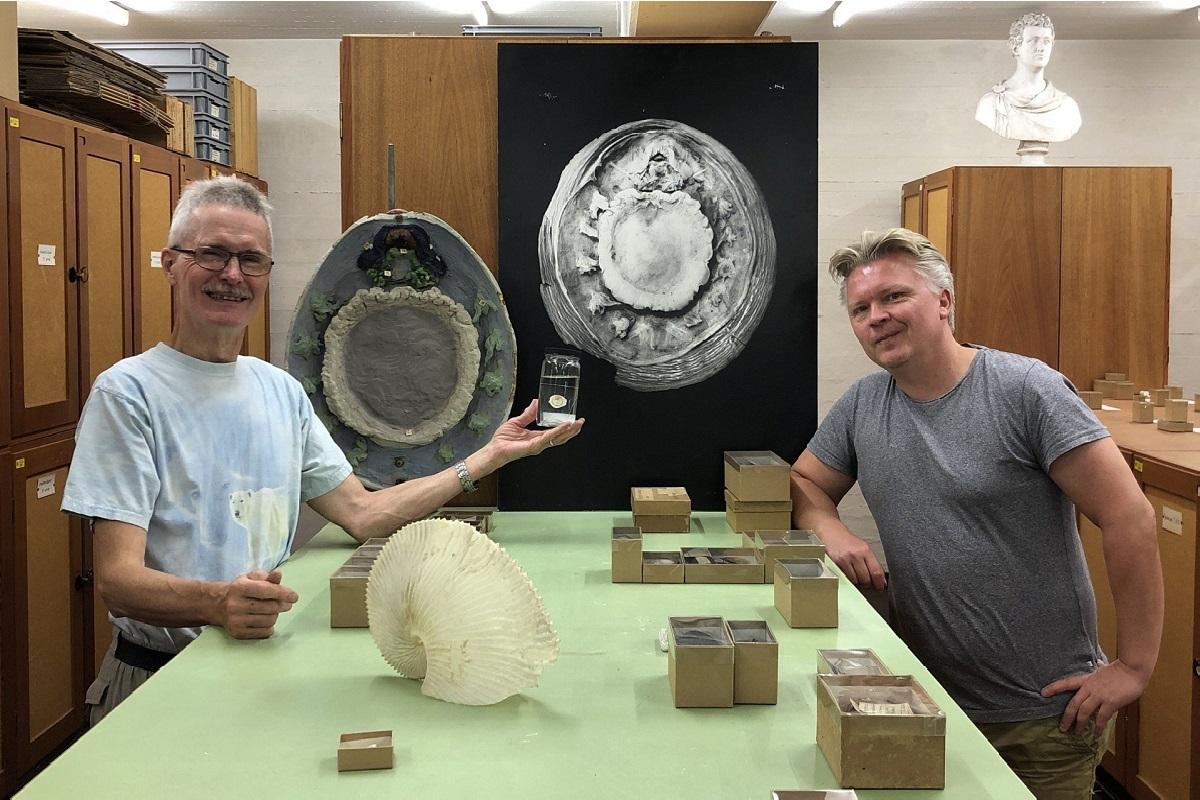Our oncoming show is called “Slimy!” and deals with mollusks. For this reason, we are interested in snails and art. When we came to know that our colleagues Tom Schiøtte and Martin Vinther Sørensen from the Natural History Museum of Denmark host the snail collection of the poet Hans Christian Andersen, who wrote tales like the "The Little Mermaid", we became quite excited and wanted to find out, what is so special about this collection… and we were surprised. However, read for yourself.
David: Thank you so much for taking some of your time to answer my questions, Tom and Martin. So what is so special about the collection of Andersen?
Tom & Martin: Frankly said, it is about the historic value, not the scientific one. Andersen collected the snails because his friend Jonas Collin asked him to do it. Collin was interested in natural history and snail research and knew that Andersen was in the habit of visiting various mansions of noble families as a house guest. Collin apparently thought that he could give Andersen a chance to be a little useful during these stays, so he asked him to collect snails in the gardens and surroundings.
Andersen and Collin knew each other, because the family Collin had helped Andersen when he was still young and unknown. He had travelled with Jonas Collin for a while and they became friends. They were a mismatched couple, their age differences was over 30 years and contemporaries said, they were bickering half of the time they spent together. But, for some reason they kept a friendship for many years, which is documented by their letter correspondence. The following citations from their letters give an idea how their communication must have looked like:
Andersen: “From your last letter I figure, that you do not appreciate the snail specimens I sent to you.”
Collin: “I do appreciate them very much. But maybe you could be a bit more specific with your collecting and focus more on the little snail with a hole at the bottom.”
Andersen: “To me it seems like all snails have a hole at the bottom …"
In a subsequent letter Collin would get the chance to pay back. Andersen had collected a garden snail which he then lost and found again under the kitchen table. He put it into a soap dish with a lid, but the maiden of the house tossed it out of the window later that day. When he related this story to Collin, he answered with priceless sarcasm:
Collin: “That you collect snails for me is very touching, but that you subsequently loose them again annuls the value of your efforts.”
The result of all of this was rather unimpressive, because the Danish snail fauna was already well known. So Andersen’s collection has a historic value and there are some funny stories connected to it, but from a scientific perspective it is, honestly to say, rather uninteresting.
David: The Andersen collection is part of a larger collection of historic items. What other interesting objects does it contain?
Tom & Martin: There are quite a few in our Mollusca collection. For example, we also have a collection from King Christian VIII of Denmark (1786-1848). For some reason, humans have been specifically interested in collecting snail shells. We have a lot of specimens that were used in the historical cabinets of the 18th century. Working with these collections can sometimes be a burden indeed.
David: A burden?
Tom & Martin: That’s a citation of our deceased colleague, the mollusk curator Høpner Petersen. The point is: these collections were assembled in an era that had very different scientific standards from today. We have to invest a lot of “detective work”, to structure the collections and investigate all data and metadata, in order to get some modern day scientific value out of them. Other museums that have more modern collections have an easier job.
David: If I asked you which object of scientific interest you would like to talk about – what would it be?
Tom & Martin: What we think is very interesting is Neopilina galatheae, a tiny, ancient deep sea animal. In the beginning of the 20th century some researchers followed, that according to evolution theory, there should exist something like a species, from which all mollusks stemmed, the “Urmollusk”. They speculated which anatomical features this animal should have and even came up with a fictional drawing. And then, in 1952 the Danish deep sea expedition Galathea found the Neopilina, an animal that resembled the “Urmollusk” drawing very closely.
David: That’s fascinating. So you are saying, that we can think up animals according to evolution theory and later find proof of it in nature?
Tom & Martin: Yes, exactly. From recent research we know, that Neopilina is probably not the grandmother of all mollusks but a derived species. But, we think that this is still a very interesting story about biology research.
David: Indeed, it is. My final question: Glitzern & Denken is an art and science project. Does your work have any relation to art?
Tom & Martin: We participated in different art exhibitions that dealt with the beauty and geometry of mollusk shells. We lent our specimens to them and cooperated with art museums.
David: Thank you very much for your time and the interesting interview.
By the way: The large natural history museums see themselves as a common scientific, global infrastructure in which the Museum für Naturkunde Berlin takes responsibility and makes knowledge available worldwide. For this reason, too, Tyrannosurus rex Tristan Otto is currently on view in the Statens Naturhistoriske Museum in Copenhagen – for research, for knowledge transfer and for nature.
